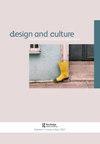Design and Political Dissent: Spaces, Visuals, Materialities
E. Berglund
{"title":"Design and Political Dissent: Spaces, Visuals, Materialities","authors":"E. Berglund","doi":"10.1080/17547075.2021.1975961","DOIUrl":null,"url":null,"abstract":"Although it is easy as well as tempting to reduce the politics of designed objects to Manichean binaries – the good versus the bad – this lively and timely volume avoids the temptation. In its pages, the semiotic and the material appear and act with a deftness and subtlety that suggest design scholarship is improving its grip on the complex ways that power travels through design culture. In nineteen chapters of different formats – case studies, interviews, responses – with sixteen color plates and generous black-and-white illustrations throughout, engaging with both professional and non-professional design practice, the volume is a welcome addition to the growing literature on design and politics. It will interest researchers and teachers of design as well as social life, while also being accessible, at least in part, to a more practice-oriented readership. The volume underscores that design research has great potential to contribute significantly to the study of the dissenting political activities that have flourished around the world in the last decade or two, and, in particular, of the creative material interventions these activities have involved. Although activist practices are an established research focus in design history, grappling with the contradictory consequences of contemporary “world making” (5) through design arguably demands new conceptual tools and vocabularies. The book is a concerted intervention into this state of affairs, aimed at engaging with political contention that is anchored in the physical world and often operates at the nonverbal level. The ambition is important quite simply because contemporary life and its spatial, visual, and material dimensions – to echo the subtitle – increasingly fail to make sense, as several authors suggest. (Ana Helena da Fonseca and Barbara Szaniecki’s chapter on the contradiction of urban construction in Rio de Janeiro is one example.) The book gives good indication that design, whether in urbanism, architecture, or product and service design, is beginning to confront its own role in the production of a disturbing sensorium. This idea, in turn, challenges conventional epistemological and political institutions, at least in the Western tradition, based as it has been around promises of technological progress and social improvement. Neither naïve nor celebratory about design, the book as a whole adopts a tone that acknowledges design’s role in creating appalling worlds and supporting practices that destroy viable and cherished ways of life. In putting such Eeva Berglund is Adjunct Professor in the Department of Design at Aalto University, Finland. eeva.berglund@aalto.fi © 2021 Eeva Berglund DOI: 10.1080/ 17547075.2021.1975961 Book Reviews","PeriodicalId":44307,"journal":{"name":"Design and Culture","volume":"14 1","pages":"108 - 111"},"PeriodicalIF":0.7000,"publicationDate":"2021-09-21","publicationTypes":"Journal Article","fieldsOfStudy":null,"isOpenAccess":false,"openAccessPdf":"","citationCount":"0","resultStr":null,"platform":"Semanticscholar","paperid":null,"PeriodicalName":"Design and Culture","FirstCategoryId":"1085","ListUrlMain":"https://doi.org/10.1080/17547075.2021.1975961","RegionNum":3,"RegionCategory":"艺术学","ArticlePicture":[],"TitleCN":null,"AbstractTextCN":null,"PMCID":null,"EPubDate":"","PubModel":"","JCR":"0","JCRName":"ART","Score":null,"Total":0}
引用次数: 0
Abstract
Although it is easy as well as tempting to reduce the politics of designed objects to Manichean binaries – the good versus the bad – this lively and timely volume avoids the temptation. In its pages, the semiotic and the material appear and act with a deftness and subtlety that suggest design scholarship is improving its grip on the complex ways that power travels through design culture. In nineteen chapters of different formats – case studies, interviews, responses – with sixteen color plates and generous black-and-white illustrations throughout, engaging with both professional and non-professional design practice, the volume is a welcome addition to the growing literature on design and politics. It will interest researchers and teachers of design as well as social life, while also being accessible, at least in part, to a more practice-oriented readership. The volume underscores that design research has great potential to contribute significantly to the study of the dissenting political activities that have flourished around the world in the last decade or two, and, in particular, of the creative material interventions these activities have involved. Although activist practices are an established research focus in design history, grappling with the contradictory consequences of contemporary “world making” (5) through design arguably demands new conceptual tools and vocabularies. The book is a concerted intervention into this state of affairs, aimed at engaging with political contention that is anchored in the physical world and often operates at the nonverbal level. The ambition is important quite simply because contemporary life and its spatial, visual, and material dimensions – to echo the subtitle – increasingly fail to make sense, as several authors suggest. (Ana Helena da Fonseca and Barbara Szaniecki’s chapter on the contradiction of urban construction in Rio de Janeiro is one example.) The book gives good indication that design, whether in urbanism, architecture, or product and service design, is beginning to confront its own role in the production of a disturbing sensorium. This idea, in turn, challenges conventional epistemological and political institutions, at least in the Western tradition, based as it has been around promises of technological progress and social improvement. Neither naïve nor celebratory about design, the book as a whole adopts a tone that acknowledges design’s role in creating appalling worlds and supporting practices that destroy viable and cherished ways of life. In putting such Eeva Berglund is Adjunct Professor in the Department of Design at Aalto University, Finland. eeva.berglund@aalto.fi © 2021 Eeva Berglund DOI: 10.1080/ 17547075.2021.1975961 Book Reviews
设计与政治异议:空间、视觉、物质
尽管将设计对象的政治性简化为摩尼教的二进制——好与坏——既容易又诱人,但这本生动及时的书避免了诱惑。在它的页面中,符号学和材料以灵巧和微妙的方式出现和表现,这表明设计学术正在提高对权力在设计文化中传播的复杂方式的把握。在19章的不同形式——案例研究、访谈、回应——中,共有16个色板和慷慨的黑白插图,涉及专业和非专业的设计实践,这本书是对不断增长的设计和政治文献的欢迎补充。它将引起设计和社会生活方面的研究人员和教师的兴趣,同时,至少在一定程度上,也可以接触到更注重实践的读者。该卷强调,设计研究具有巨大的潜力,有助于研究过去一二十年中在世界各地蓬勃发展的持不同政见的政治活动,特别是这些活动所涉及的创造性物质干预。尽管激进主义实践是设计史上一个既定的研究重点,但通过设计来解决当代“世界制造”(5)的矛盾后果无疑需要新的概念工具和词汇。这本书是对这种情况的协调干预,旨在参与植根于物理世界的政治争论,并且经常在非语言层面运作。正如几位作者所说,野心之所以重要,很简单,是因为当代生活及其空间、视觉和物质维度——与副标题相呼应——越来越没有意义。(安娜·海伦娜·达·丰塞卡(Ana Helena da Fonseca)和芭芭拉·萨尼茨基(Barbara Szaniecki)关于里约热内卢城市建设矛盾的章节就是一个例子。这一想法反过来挑战了传统的认识论和政治制度,至少在西方传统中是这样,因为它一直围绕着技术进步和社会进步的承诺。这本书对设计既不天真,也不庆祝,整体上采用了一种基调,承认设计在创造骇人听闻的世界和支持破坏可行和珍视的生活方式的实践中所起的作用。Eeva Berglund是芬兰阿尔托大学设计系的兼职教授。eeva.berglund@aalto.fi©2021 Eeva Berglund DOI:10.1080/17547075.2021.1975961书评
本文章由计算机程序翻译,如有差异,请以英文原文为准。


